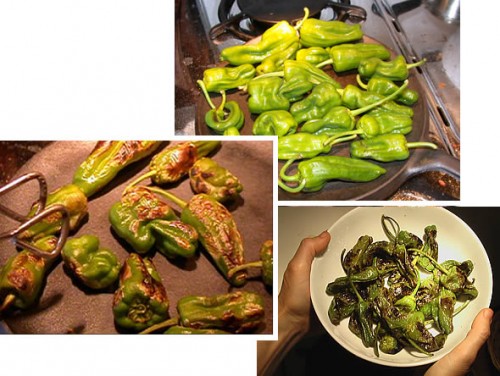Cooking Padrón peppers – I have got this dialed in now, and they are so so so delicious prepared this simple way that I never prepare or use them any other way. There are never left-overs.
The best pan for preparing them is a dry cast-iron skillet or comal. I know that from the outset this may deter some of you, so after I’ve described how I make them I’ll offer some alternatives for those of you don’t have this kind of cookware.
It is quite simple, really. As usual, it is all about the quality of the ingredients — of which there are only three: 1) the Padrón peppers themselves, 2) a really good quality, flavorful olive oil (I love using Apollo olive oil, but there are lots of good ones out there, and Taylor would probably say I was remiss if I didn’t remind you that you can get a good local Valencia Creek olive oil through the web store), and 3) a good, coarse sea salt. Come to think of it, you can also get the wonderful local Monterey Bay Sea Salt through the web store too! Its coarse, faintly moist, crumbly texture is perfect for this. That’s what I use.
If you’ve refrigerated your Padróns, try to remember to bring them to room temperature before cooking; not a deal-breaker, but I think they brown a little more evenly (and quicker) if they’re not chilled.
Pick the peppers over and remove any odd bits of schmutz or dirt, if any. (Sometimes there’s a brown, papery bit around the base of the stem – vestiges of the old blossom, perhaps?) Leave peppers whole, stems intact. The stems are handy handles to hold them by when eating, so don’t cut them off!
Heat your comal or griddle or cast iron skillet dry — i.e. no oil. The oil in this preparation is for seasoning with afterwards, NOT for cooking. Have a pair of tongs handy, and maybe an oven mitt or similar, because you’re going to have some serious heat radiating off your pan. Heat it good and hot (not cherry-red hot; we’re not doing “blackened” anything, but if a spritz of water on its surface should dance a quick jig and vanish almost as quickly, then it’s ready).
Spread the Padróns in a single layer on the hot skillet (if you have a lot of peppers to prepare, do them in batches; they need to all be in contact with the hot metal). Oft-times the peppers will dance and jiggle just like the water did; fun to watch. After about a minute, start to turn them with your tongs, and keep cooking and turning them every minute or so, until they are mostly browned and blistered (some black spots are fine), and going limp. Remove them to a bowl as you determine they are done (some will cook faster than others).
Once they’re all done and in the bowl, drizzle with your good olive oil and toss lightly to coat. You will notice that the heat radiating off the peppers volatilizes the olive oil in the most fabulous way, creating this heady aroma of roasted padron [once you are familiar with the smell, you won’t forget it] and olives… it is really something! Now just sprinkle the sea salt over all and call everyone to the table (if they’re not already in the kitchen with you, lured there by the smell) and eat them! As Tom says, have something cool standing by in the event you get a hot one, but mostly they are just really, really tasty and not hot at all. I hold them by the stem and bite off and eat everything else, especially if they’re small. If they’re bigger, I’ll take a tentative nibble first, as they’re more likely to be hot, but I have found more often than not that size does not matter; sometimes little ones will be hot, and sometimes big ones will not.
Here are some pictures, and below, as promised, alternative cooking methods.
I think you will probably have decent success if you use a regular skillet; in this instance I would put a little oil in the pan (not your good stuff!), and go as hot as you can without warping the pan (heat oil until almost smoking, then toss in the peppers). The oil will help give them that surface contact and transfer the heat. Stir/toss often though, and then when done treat them the same as above: transfer to a bowl, drizzle with the good olive oil, sprinkle with the salt.
Do you have a griddle? A griddle would probably work too. Or an electric skillet.
Lastly, although I have not tried it, it seems logical that you could roast them in the oven just like you do other peppers; try a fairly hot oven — say, 475° F — and spread them in a single layer in an ovenproof baking dish. Give ’em ten minutes and check in on them. Are they starting to blister? If not, leave them in until they do. You probably want to pull the dish out and turn them once, or at least shake the dish to get them to roll about. Once they are blistered, proceed as above with the olive oil and salt.
Oh yes — and of course if you should happen to have a wood-fired oven, you can roast them in there!



